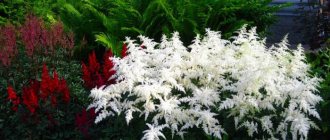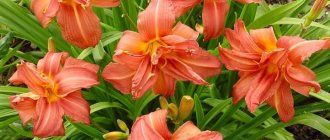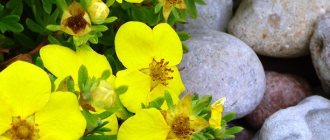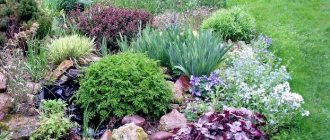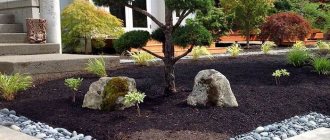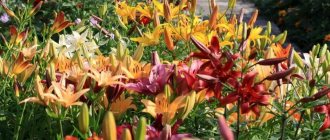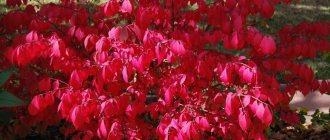I have a place near my house where only coniferous plants grow. It so happened that an area was formed where precisely such a unique specimen as Microbiota Crosspair was missing. It has similarities with thuja orientalis and juniper.
I don’t know of any particular concerns with the microbiota; it grows slowly, and the needles delight with their lushness and changing shades all year round. In this article I want to share my knowledge about this very ornamental shrub, the rules of planting and care. And photos in landscape design will help you decide in favor of Crosspair Microbiota.
Description of ephedra microbiota
Microbiota is a representative of coniferous shrubs from the Cypress family. The genus is represented by a single species – cross-paired microbiota (Microbiota decussata), which includes a small number of varietal varieties.
The Far Eastern regions of Russia are considered to be the homeland of the shrub; due to a significant reduction in numbers, the shrub is listed in the Red Book of the Russian Federation.
The height of the bush shoots reaches 50 cm. The shell-shaped crown is formed from creeping shoots; its diameter can reach two meters.
A feature of Microbiota is the change in color of the needles depending on the season. In spring, the needles of this plant are bright green, in summer they become dark green, and in autumn they gradually acquire a bronze tint. It stays this color until spring returns and then abruptly returns to green.
The shoots are thin, flat in shape, tightly adjacent to the ground. They are covered with scaly needles, rich green in color, about 2 mm long. The needles tightly envelop the shoots, their ends are slightly pointed at the top. Brown cones, round in shape, small. Their length reaches 0.6 mm, width – 0.3 mm. After the scales ripen, the cones open, releasing a rounded seed. The period of seed ripening is summer-early autumn.
You might be interested
Why do coniferous trees turn yellow?
What fertilizers for coniferous plants can be used in the garden
How to care for coniferous plants in your garden
Kinds
Microbiota crosspair is the only species of its genus. But during the popularization of the plant, many varieties were bred. The most famous:
- norzen pride. Spreading shrub, slightly different in color and size. Planted in large open areas.
- Celtic Pride. A close and neat bush, often used in creating flower arrangements.
- goldspot. The color of the branches is variegated, with golden spots.
- carnival It also has gold inclusions, but in a larger area.
- Jacobsen The branches of the bush are dense and twisted.
Rules for growing microbiota cross-pair
Coniferous trees and shrubs, as a rule, are quite independent and require little human help. With proper care, Microbiota decussata will provide you with a charming look for many years.
The soil
Moist and well-drained soils will ensure the best growth for your shrub. These plants can tolerate poor soils, but they grow quickly in loam soils.
Whenever possible, use a quickly decomposing mulch, such as dried leaves, around new plantings. This helps keep the soil moist and protects it from erosion. Once the plant takes root and grows in size, it becomes living mulch. In winter, wood chip mulch will protect the plant's roots from cold damage.
Lighting
While most coniferous crops prefer sunlight, Microbiota prefers partial shade. In fact, that's where it grows best. Although the plant can tolerate full sun in milder climates, it is easiest to plan for shelter. It can grow in complete shade, but performs best if it receives at least some sunlight.
Water
The plant likes constant humidity, but does not like standing water. The soil should be evenly moist, but not soggy. Once established, the microbiota is very drought tolerant. Its roots can draw moisture from the depths.
A slow, gradual watering method is preferred for this plant. It is best to use drip irrigation to soak the soil under your plants. This allows moisture to seep into the soil and penetrate completely. Water only when the soil is dry at the surface, but give it a long, slow watering to thoroughly saturate the soil.
If you have a humid climate, make sure your plant has shade during the hottest parts of the day. The combination of humidity and heat can slow its growth. Nighttime humidity doesn't matter.
Fertilizers
If you plan to fertilize, it is best to do it in early spring, before new shoots emerge. Use a balanced, slow-release fertilizer, preferably in granular form. They are easy to apply at the base of your plants.
But don't think that this is a necessity. The microbiota tolerates poor soil nutrition well. It will survive even without fertilizer. If your soil is rich enough, you can skip feeding at all.
Trimming
Carry out pruning in early spring, focusing on the tips of the branches. Be sure to prune before the plant starts to green up again. This annual sanitary pruning promotes bushier growth. You can also perform formative pruning to prevent the crown of the bush from growing. When pruning, be sure to use clean pruning shears to make a clean cut.
Landing
The microbiota is planted in a special hole depending on the size of the root. The root collar should not go deeper into the soil than 1-2 cm. At the bottom of the hole you need to put 0.2 m of drainage, for which it is better to take stone chips or crushed stone. You also need to add sand and compost.
Watering
Watering the microbiota must be done regularly. It is worth watering the bush only when the top layer of soil has already dried out. In the absence of rain, the microbiota needs to be watered twice a week. After natural precipitation resumes, there will be no need for such heavy watering. In addition, the plant must be sprayed every evening. When watering rego, you need to pour 5 to 7 liters of water under each specimen every day.
Top dressing
Growing microbiota is impossible without applying fertilizers. You can use mullein solution.
Important! Do not use manure to fertilize the microbiota: it is harmful to the plant. Also use mineral fertilizers, but wisely: the microbiota is very sensitive to the composition of the fertilizer
- Do not use nitrogen, as the plant will not be able to survive the winter and will die: the shoots will turn yellow and extensive chlorosis will begin.
- Manure is also contraindicated for shrubs.
- But compost at the rate of 3-5 kg per 1 sq. m will come in handy.
- Vermicompost also works well for feeding this plant.
- It is also necessary to feed the microbiota with microelements. Otherwise, chlorosis may occur.
- In addition, the plant does not tolerate stress: the shoots may not ripen after wintering.
- Magnesium should also be used. Microbiota, like any plant, needs to “breathe”, but as a conifer it does not contain leaves. Therefore, it is necessary to additionally help the plant to form photosynthesis. And magnesium is precisely contained in the core of the chlorophyll molecule, which means it will help the shrub in the formation of photosynthesis. This element should be given in the form of dolomite flour or in fertilizers that contain magnesium.
- Give the microbiota a lot of microelements.
- Remove nitrogen from fertilizing.
- Use magnesium as the main component of nutrition.
The microbiota needs to be fed twice a year. It is best to do the first feeding in May, the second in August, in order for the plant to prepare for winter.
Popular articles How to fry pine nuts
In May, it is best to fertilize the bush with the preparation “Uniflor Bud” - it contains magnesium, almost no nitrogen and many microelements. “Uniflor Cactus” is also suitable - among other things, it contains calcium and the same amount of microelements as in “Uniflor Bud”.
To prepare the solution, take 2-3 ml of fertilizer, dilute it in 3 liters of water and water the ground around the plant. When using sprinkling, take the same amount of fertilizer, but dilute it in 10 liters of water, otherwise there will be burns on the planting.
Loosening
It is very important to loosen the soil where the roots of the microbiota lie. Loosening is necessary to destroy soil compaction and remove the roots of harmful plants
You need to loosen it very carefully so as not to damage the roots of the bush. Loosening is carried out in the spring as soon as the snow melts and the ground dries out from the excess moisture in it. Further loosening is carried out as necessary - when the soil is compacted. Most often they are loosened during the growing season.
Important! The depth of loosening should not exceed 3-5 cm
Weeding
Weeding is necessary to control weeds: they take away light from the bush, territory for growth and useful substances from the ground. In addition, weeds favor the development of diseases in the plant, as well as the appearance of harmful insects on it. The use of chemicals is undesirable. They are used only in emergency cases.
Transfer
The shrub does not tolerate transplantation without a root ball. For transplantation, shoots lying on the soil are used. Cuttings are taken 8-10 cm in size. It is necessary to use root formation stimulants, such as “Kornerost”, “Heteroauxin”, “Kornevin”.
Wintering
In order for the bush to overwinter well, it needs to be prepared for winter. To do this, at the end of autumn it must be thoroughly watered. You need to pour at least two buckets under each bush. In winter, the snow that has covered the microbiota must be swept away, as it can break the branches of the bush.
Microbiota Reproduction
The shrub reproduces by seed and vegetative methods. Considering that Microbiota is a dioecious plant in which males predominate, propagating it by seed is quite problematic. Females begin to produce seeds only from the fifteenth year of life.
Vegetative propagation is a faster option to get a new plant. The branching technique is widely used, when branches pressed to the ground take root, giving life to a new bush.
Cuttings are also widely used for propagation. Cuttings are carried out throughout spring and summer. For cuttings, young, healthy, annual shoots about 10 cm long are used. The edge of the shoot is treated with a rhizome stimulating agent and planted in a container. During the rooting process, you need to keep the soil moderately moist.
Transplantation of cross-pair Microbiota into open ground is carried out in the next season, when the root system has grown sufficiently and become stronger. When planting, the rhizome is not buried in the ground. The planting hole should be slightly larger than the roots of the plant. When planting Microbiota, be sure to use large crushed stone or other drainage material, which will optimize the moisture level and allow the shrub to develop better. The distance between single plantings should be at least one meter, and for group plantings - about 5 cm.
How to propagate a plant yourself
Reproduction of microbiota, if desired, is easy to do yourself. This is done using the following methods:
- seeds;
- using cuttings.
Since cones rarely appear on the plant and it is difficult to extract seeds from them, amateurs often use the second propagation method.
Microbiota seedling
To grow microbiota from green cuttings, perform the following work:
- In mid-summer, young but already lignified shoots with a heel are cut.
Advice. It is better to prepare cuttings for propagation in cloudy weather. This will protect both the cuttings themselves and the cuttings on the mother plant from damage from sunlight.
- The cut branches are freed from needles and bark to a height of 3-4 cm.
- The bottom of the planting container is covered with drainage material. Loose and nutritious soil is poured on top. A 1:1 mixture of sand and peat is suitable. Provide abundant watering.
- According to the number of cuttings, round holes of small diameter are made in the soil at an angle of 60°.
- A cutting is placed in each hole to the depth of the cut bark and squeezed.
- A greenhouse is built above the box.
Caring for cuttings includes watering and daily ventilation. Fertilizer is not needed during germination. Roots appear after 2.5-3 months. Until next summer, the plants are grown indoors.
Microbiota in landscape design
Problems in caring for coniferous shrubs
Overwatering is the most common and dangerous problem for your plant. Cross-paired microbiota does not tolerate standing water - remember this.
A hot climate can be very, very dangerous for a plant. Large amounts of direct sunlight in warmer regions can be deadly to plants. The shrub must be kept in complete shade. The cross-paired microbiota prefers cooler regions.
Don't panic when your plant turns bronze in winter! This is a normal process. It will turn green again in the spring. Mulch the base of the plant with wood chips to protect the roots from the cold.
Pests and diseases
Unlike many other ground cover plants, the shrub is practically not attacked by pests.
The microbiota is immune to many types of plant diseases. Damaged roots can sometimes be susceptible to bacterial or fungal rot. Likewise, damage to the base of the plant can leave it open to bacterial infection. But in general this is unlikely.
Use in the garden
Bushes with lacy needles, spreading as a solid green mat, can take their rightful place in the garden when planted singly or in groups on rocky areas, and also as borders. Since microbiota is a ground cover plant, it can be used to both decorate and strengthen slopes. It does not lose its attractiveness in cold weather, it only acquires a special shade of pine.
Microbiota in the form of a standard tree
Quite often you can find microbiota grown in garden containers. As a potted crop, it feels quite comfortable, growing upward and forming a small tree.
Application of cross-pair Microbiota in garden design
Due to its external beauty, it is widely used for landscaping summer cottages in single plantings and in group plantings.
Often the microbiota is planted in the foreground of large coniferous plants, which creates a contrast of figures and puts accents in the composition. Good susceptibility to growth on slopes and mountainous areas makes the shrub an ideal solution for rock gardens and rockeries.
This plant is often used on hillsides to control erosion. This is an excellent replacement for a lawn. When combined with other evergreens, it can be quite colorful. The plant is especially often used in coniferous compositions. Its dark bronze autumn color makes the bush stand out among greener plants.
Diseases and pests
Delosperma is quite resistant to pests and diseases. However, if liquid stagnates in the soil, for example, due to frequent watering or too dense soil, then the flower may rot.
The most common pests that settle on the bush are:
- Mealybug. The bushes are sprayed with an insecticide solution, the main active substance of which is cypermethrin.
- Aphids. If there are few pests, then dissolve half a bar of laundry soap in 5 liters of hot water. When the mixture has cooled, the bushes are treated with it.
- Spider mite. Using a cotton swab moistened with soapy water, remove as many pests from the plant as you can. Then it is sprayed with a solution of a chemical or biological acaricide.
Botanical certificate
The discovery of a unique plant - microbiota, hitherto unknown to the botanical world, became a sensation of the last century.
The culture is characterized by slow growth; even in adulthood, the height of the microbiota rarely exceeds 1 m, while the diameter of the crown can reach 5 or more meters, therefore, when planting in open ground landscape compositions, it is worth considering the presence of a significant free area around the plant.
In nature, microbiota can be found on the mountain slopes of Sikhote-Alin; the plant climbs to a height of up to 1.6 thousand meters above sea level, where it grows on rocky soils, blown from all sides by harsh winds. It is persistent and easily tolerates severe frosts in winter, which does not in any way affect the health of the plant. The microbiota has adapted to frequent forest fires - its seeds germinate on barren, scorched land, giving good growth in the first year.
The plant has green, scale-shaped needles, which turn copper-colored in autumn and turn brown in winter. Against the background of autumn trees, an elfin bush with bright copper needles looks very unusual.



